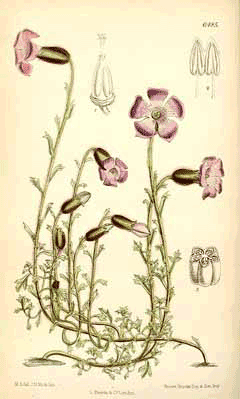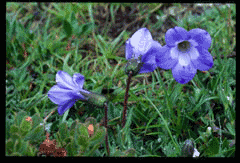 |
|
http://commons.wikimedia.org/wiki/File:Cyananthus_lobatus.jpg |
 |
| http://androsace.com/ |
Translate this page:
Summary
Physical Characteristics

 Cyananthus lobatus is a PERENNIAL growing to 0.1 m (0ft 4in) by 0.5 m (1ft 8in).
Cyananthus lobatus is a PERENNIAL growing to 0.1 m (0ft 4in) by 0.5 m (1ft 8in).
See above for USDA hardiness. It is hardy to UK zone 3. It is in flower from September to October. The species is hermaphrodite (has both male and female organs).
Suitable for: light (sandy), medium (loamy) and heavy (clay) soils. Suitable pH: mildly acid, neutral and basic (mildly alkaline) soils. It can grow in semi-shade (light woodland) or no shade. It prefers moist soil.
UK Hardiness Map
US Hardiness Map
Synonyms
Plant Habitats
Cultivated Beds;
Edible Uses
References More on Edible Uses
Medicinal Uses
Plants For A Future can not take any responsibility for any adverse effects from the use of plants. Always seek advice from a professional before using a plant medicinally.
Laxative Stomachic
The flowers are used in Tibetan medicine, they are said to have a sweet, astringent and acrid taste with a cooling potency[241]. They are laxative and dry up serous fluids, and are used in the treatment of various serous disorders and constipation[241]. The juice of the root, mixed with a equal quantity of the root juice of Valeriana jatamansii, is used in the treatment of peptic ulcers[272].
References More on Medicinal Uses
The Bookshop: Edible Plant Books
Our Latest books on Perennial Plants For Food Forests and Permaculture Gardens in paperback or digital formats.

Edible Tropical Plants
Food Forest Plants for Hotter Conditions: 250+ Plants For Tropical Food Forests & Permaculture Gardens.
More

Edible Temperate Plants
Plants for Your Food Forest: 500 Plants for Temperate Food Forests & Permaculture Gardens.
More

More Books
PFAF have eight books available in paperback and digital formats. Browse the shop for more information.
Shop Now
Other Uses
References More on Other Uses
Cultivation details
Prefers a low-fertility, deep, gritty, cool and humus-rich soil, preferably acid, though most members of the genus will tolerate a little lime[200]. Tolerant of high summer rainfall, thriving in moist soils if these have perfect drainage[200]. Plants are hardy to at least -15°c[200]. There are some named forms, selected for their ornamental value[200].
References Carbon Farming Information and Carbon Sequestration Information
Temperature Converter
Type a value in the Celsius field to convert the value to Fahrenheit:
Fahrenheit:
The PFAF Bookshop
Plants For A Future have a number of books available in paperback and digital form. Book titles include Edible Plants, Edible Perennials, Edible Trees,Edible Shrubs, Woodland Gardening, and Temperate Food Forest Plants. Our new book is Food Forest Plants For Hotter Conditions (Tropical and Sub-Tropical).
Shop Now
Plant Propagation
Seed - best sown in the autumn as soon as it is ripe[200]. Only just cover the seed and place it in a cold frame. Prick out the seedlings into individual pots as soon as they are large enough to handle and grow them on in the greenhouse until large enough to plant out (this is best done in early to mid summer). Softwood cuttings in spring[200].
Other Names
If available other names are mentioned here
Native Range
TEMPERATE ASIA: China (Xizang Zizhiqu (southeast), Yunnan Sheng (northwest)) TROPICAL ASIA: Bhutan, India (Arunachal Pradesh, Himachal Pradesh, Jammu and Kashmir, Sikkim, Uttar Pradesh), Nepal, Myanmar (north)
Weed Potential
Right plant wrong place. We are currently updating this section.
Please note that a plant may be invasive in one area but may not in your area so it's worth checking.
Conservation Status
IUCN Red List of Threatened Plants Status :

Growth: S = slow M = medium F = fast. Soil: L = light (sandy) M = medium H = heavy (clay). pH: A = acid N = neutral B = basic (alkaline). Shade: F = full shade S = semi-shade N = no shade. Moisture: D = dry M = Moist We = wet Wa = water.
Now available:
Food Forest Plants for Mediterranean Conditions
350+ Perennial Plants For Mediterranean and Drier Food Forests and Permaculture Gardens.
[Paperback and eBook]
This is the third in Plants For A Future's series of plant guides for food forests tailored to
specific climate zones. Following volumes on temperate and tropical ecosystems, this book focuses
on species suited to Mediterranean conditions—regions with hot, dry summers and cool, wet winters,
often facing the added challenge of climate change.
Read More
Expert comment
Author
Wall. ex Benth.
Botanical References
200
Links / References
For a list of references used on this page please go here
Readers comment
| Add a comment |
|
If you have important information about this plant that may help other users please add a comment or link below. Only comments or links that are felt to be directly relevant to a plant will be included. If you think a comment/link or information contained on this page is inaccurate or misleading we would welcome your feedback at [email protected]. If you have questions about a plant please use the Forum on this website as we do not have the resources to answer questions ourselves.
* Please note: the comments by website users are not necessarily those held by PFAF and may give misleading or inaccurate information.
To leave a comment please Register or login here All comments need to be approved so will not appear immediately.
|
Subject : Cyananthus lobatus
|
|
|
|